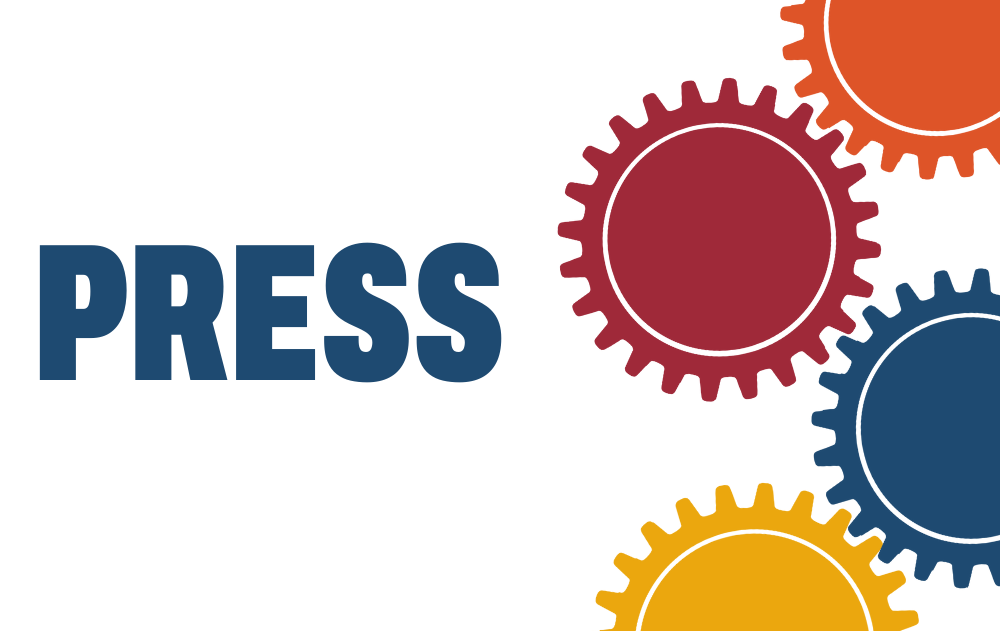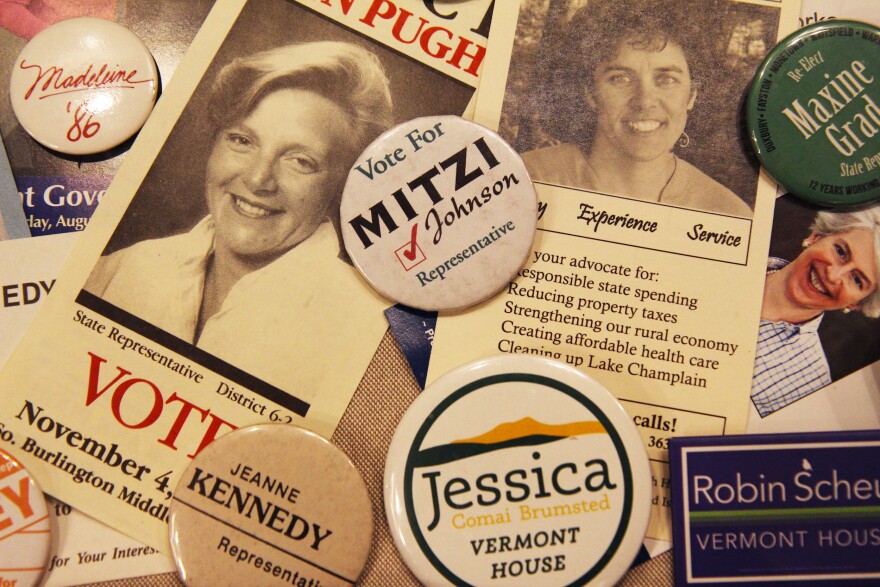Group Calls On Vt. Newsrooms To Address Gender Bias, Lack Of Diversity In Coverage

This article was originally published by Vermont Public on January 26, 2021. VWW Executive Director Rhoni Basden joined Mitch Wertlieb to discuss gender bias in Vermont news coverage and gender equity in Vermont. Through programming, partnerships, and policy, VWW works to advance gender equity in Vermont, and ensure education and work are equitable and accessible for all.
Vermont Public | January 26, 2021
By: Mitch Wertlieb and Matthew Smith

A case of campaign leaflets and buttons from the Vermont Statehouse display called Women In The Vermont Statehouse. The Vermont Has Her Back group is calling on Vermont media outlets to address gender bias in their coverage.
The “Vermont Has Her Back” group sent a letter to newsrooms across the state this week, calling on the Vermont press corps to diversify in more ways than one. Signed by more than 50 individuals — ranging from business owners, to nonprofit leaders and former governors — the letter calls for greater diversity in the voices and experts the news features and the stories the industry covers, as well as in how those stories are covered. The group has also called for greater diversity among the journalists telling those stories.
VPR’s Mitch Wertlieb spoke with Rhoni Basden, executive director of Vermont Works for Women, a nonprofit that works to advance gender equity in Vermont. She is a signatory of the “Vermont Has Her Back” letter. Their conversation has been edited for clarity.
Mitch Wertlieb: Your letter cites some specific examples of reporting by Vermont media outlets that essentially fail the standard that prompted the letter in the first place. Can you give us some examples of what you’ve seen or heard in local media that illustrates the problems identified in your letter?
Rhoni Basden: I think when it comes to talking about candidates running, or even those women in leadership roles now, that it’s not just talking about women’s clothing; it’s questioning competence and their ability as leaders because of their gender.
We want fair reporting to evaluate candidates and elected officials, really based on the merits of the policies that they’re presenting and the quality of their character, and not assumptions made because of their gender. So that goes along with: yes, reporting about their clothing or their skin, or even some of their mannerisms — women [being] described as “too aggressive” or “too shrill,” versus male counterparts being described as “bold.”
Are these things you’ve seen happen in Vermont, either in print, radio or television?
Yes, absolutely. I think, definitely in the last election cycle, there were many different examples — and many examples called out — of how [when covering] women running for office, [news media] talked about their clothing, whether it was pencil skirts or pantsuits or, you know, the tone of their voice, and those same mannerisms or those same characteristics were not described about their male counterparts.”
Right now, the Statehouse has a historic number of women in leadership roles; both in the Senate (there’s Senate President Becca Balint), and in the House (with Speaker Jill Krowinski and House Minority Leader Pattie McCoy). And Vermont has just elected a female Lieutenant Governor, Molly Gray — just the fourth woman to hold that post in the state’s history.
Now, Vermont does remain the only state that’s never sent a woman to Congress. There’s been just one woman governor in the state’s history. Do those leadership roles in Montpelier this year indicate that a shift in the right direction is already underway? Or is that kind of a Pollyanna way of looking at things?
No, I believe there’s absolutely momentum as we look at the incredible leadership that we have at our state level right now. And I think conversations are starting to happen that need to happen.
And I think this letter is just the beginning of really engaging in meaningful conversations around how we’re addressing issues of sexism, and gender bias, and racism in our reporting and in our leadership roles.
How is the next generation seeing representation at all levels? And that really does build a pathway, I think, to make change for Vermont to hopefully no longer be the only state to have not elected a woman to the federal level.
One of the things that you call on the Vermont press corps to do is to diversify — in more ways than one. What would you like to see happen as a result of this letter when it comes to diversity?
Just as much as we call for diversity in leadership positions, we need diversity in reporting, and in journalism, and in our press corps. So having more women reporting would be wonderful. Having more people of color reporting would be wonderful.
It diversifies what we’re hearing. It diversifies the points that are being made. And I think it allows a broader picture of who is running for these positions or who is seated in them.
This letter was just sent out Monday. Have you been getting a response from media outlets so far? And what has that response been like?
There actually has been a great response so far just from the general community, for the letter, really supporting the initiative, but also from the press corps. VPR and Vermont Digger both have had very positive responses about it. And I think engaging in the conversations are the best places to start today.
There is news media, but of course, there’s also social media. And we have seen how people have abused social media in everything from trolling to doxing, making threats. I mean, it can be just a cesspool — let’s face it. There’s no shortage of that behavior that targets women, especially women in positions of power. Is this an issue that’s deeper than just demanding that news organizations do better? I mean, how can we address these deeper social issues so all of us can do better?
Absolutely. Social media has definitely taken on a whole new realm of what’s possible. There’s a lot of safety behind a keyboard, rather than in front of somebody. I think we’re starting to see more ways in which we’re controlling and mandating and calling people out more for what they’re saying online, and holding people more accountable. I think there is a lot more that needs to be done; one, for adults, but two, also for our next generation of kids that are exposed to this in a much bigger way.
So while yes, I’m seeing a lot more positivity as far as controlling some of these, there is a lot more that needs to be done and a lot more ways that I think we can have more oversight and accountability for what is said online.
One of the things that’s pointed out, that I find really interesting, is that while women outnumber men [as chairs of House and Senate committees], male lawmakers are quoted 56% [of the time] compared to 44% for women lawmakers, when journalists go to find out information and ask questions.
Do you think this is happening as an unconscious bias, or would somebody push back and say, “Well, they’re just going for those experts in that particular field, according to a particular question, it may turn out that there are more men than women”?
I think it could be unconscious at times, but I think there definitely needs to be more [done] when the story is written, making sure that there is equity in the quotes that are being used, and that there are fair voices across the table that are being heard, and [it’s about] really making sure that it’s not dominated by one side of the table, or by one gender, or by one side of the issue.
And so, while yes, [there is] unconscious [bias], but I think there can still be moments of reflection, where you look back and say, we need to go back and get more voices, more comments, more quotes to include in the story.
And ultimately, Rhoni, what would you like to see as far as saying, “OK, this letter was successful or at least moved the needle a little bit?” Because the letter goes out and, you know, you can get the right responses, but what would that benchmark be, where you can say, “OK, this has been successful,” or “We need to push back harder?”
I don’t think that there is a box to check to say when it is over. But I think, you know, this is a start.
Having more meaningful conversations, really engaging both internally within organizations and businesses, but also bringing more outside voices to the table to talk about how we can do better. So, how can we do better in reporting? How can we do better in other industries, and in other fields as well?
But I think starting here with conversations, and continuing to have them, so continuing to look at who is reporting and do we have diversity in our reporters and in our journalists? You know, a continuous look at our leadership roles. Are we continuing to see the equity at the table? And are we addressing the issues that were brought up in this letter on an ongoing basis and not just at one time?